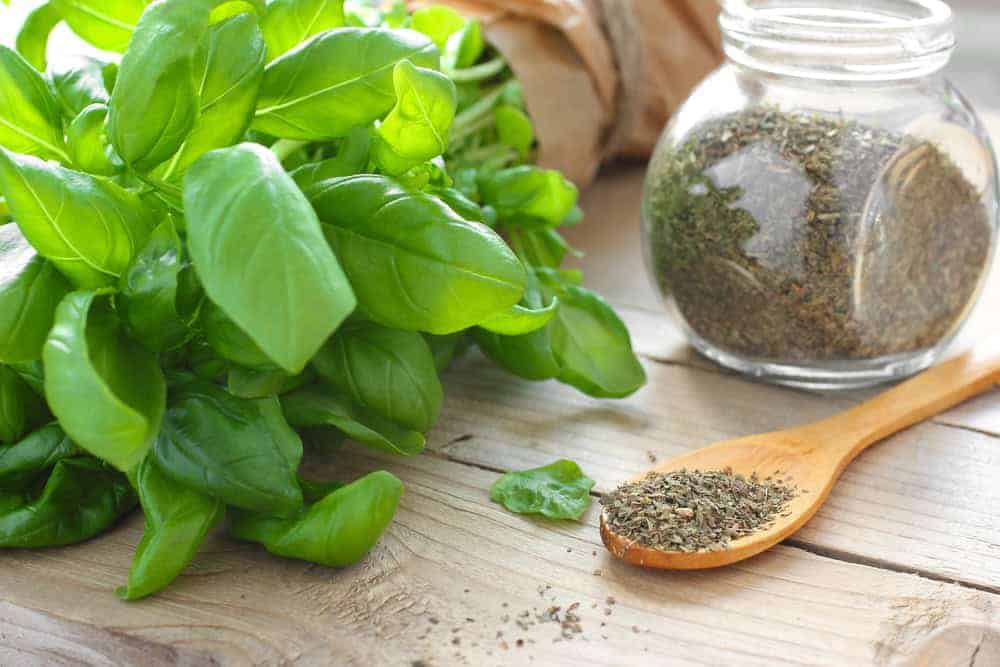
Basil and oregano – two Italian spices beneficial for health
Among the many cuisines of the world, Italian cuisine stands out particularly favorably, with its use of spices that not only improve the taste of food, but also weaken health. Some of them are worth introducing into your daily menu, and two of the most popular are certainly basil and oregano. Not only do they delight with their unique flavor and aroma, they also allow you to replenish essential nutrients.
Contents
- 1 Is Italian cuisine healthy?
- 2 What is basil?
- 3 What nutrients do the leaves and other parts of basil contain?
- 4 What is oregano?
- 5 What distinguishes the chemical composition of oregano?
- 6 Which medicinal properties of basil and oregano are worth highlighting?
- 7 What is the recommended daily dosage of basil and oregano?
- 8 Are there contraindications to the consumption of basil and oregano?
Is Italian cuisine healthy?

We associate Italian cuisine with the warmth of this beautiful country and, at the same time, with many popular dishes, among which the primacy is certainly led by various types of pasta served with a variety of aromatic sauces. For the most part, they are made with tomatoes and other vegetables, but there is a constant debate about their effects on health, primarily whether they are fattening or not.
There is no denying that some dishes, especially traditional Italian cuisine, can become the cause of growing overweight and obesity, although this is not always the rule. However, most nutritionists emphasize in their opinions its beneficial effects on health, which characterizes most Mediterranean cuisine. It contains a lot of vegetables, fruits, while less meat, and consumes a lot of fish and seafood. Most dishes are prepared with extremely healthy olive oil, usually extra virgin, or extra virgin.
The proverbial first fiddle is played by spices, completely different from those we use in our country, and the two most commonly used are just basil and oregano. They can be used in dried form, but a true Italian chef and Italian housewife always use fresh leaves, growing in the garden or a pot, and it is such that retain their full nutritional value.
What is basil?

We will start the description of these two tasty and healthy herbs in alphabetical order, with basil. This is a plant that has been known since ancient times, occurring in many varieties, widely used not only in the kitchen, but also in medicine and cosmetics. Basil is included in the light family, nearly 70 species are known, growing in different parts of the world, but mostly in subtropical climates. Among the best-known species of this tasty plant, we can include such three as:
Common basil (Ocimum basilicum)
It is the one we use to enhance the flavor of Italian dishes, giving them that distinctive spicy yet sweet taste. It is an annual plant, growing up to about 50 cm in height, and its use is in its leaves, light green, up to 5 cm long, equipped with glands that produce essential oils.
Lemon basil (Ocimum basilicum citrodora)
It differs from the common variety in the length and shape of its leaves, which are more pointed and, above all, its lemon flavor and fragrance. The leaves of lemon basil can also vary in color, from light green to red with purple fragments. Not only its leaves, but also its flowering tops are used.
Cinnamon basil (Ocimum basilicum cinnamon)
As its name suggests, having the characteristic taste of another popular and healthy spice, cinnamon. Also finds use in cooking, but usually not in meat dishes or sauces, but for seasoning cakes and desserts.
What nutrients do the leaves and other parts of basil contain?
If basil is to find use not only as a tasty addition to, for example, tomato sauce, then it must replenish nutrient deficiencies in the body. Analyzing its composition, you will immediately notice that it really has something to boast about, and these tasty green or dried leaves contain:
- vitamin A;
- B vitamins, including folic acid (B9);
- vitamin C;
- vitamin K;
- mineral salts: zinc, phosphorus, magnesium, manganese, potassium, calcium and iron;
- flavonoids;
- terpenes;
- tannins.
What is oregano?
Another Italian spice worth having not only in your kitchen, but also in your home herbal medicine cabinet, is oregano. Its other used name is common lembi and its flavor, aroma and medicinal properties were appreciated as far back as ancient Rome and Greece at the time.
Oregano, called wild marjoram in our country, belongs to the light family and grows not only in Europe, but also in Asia and Africa. It forms a branching stem growing up to 80 cm in height, and both it and the 4 cm long leaves emit a characteristic odor. Herbal material and improving the taste of dishes are mainly leaves, which can be used in fresh or dried form.
What distinguishes the chemical composition of oregano?

Like the basil presented earlier, oregano also stands out from other Mediterranean spices due to its unique, rich composition. The most important, at the same time determining the smell and taste of the plant, are two essential oils, karwakrol and tymol. Of course, these are not the only active compounds, oregano leaves also contain:
- vitamin A;
- beta-carotene;
- B vitamins: thiamine (B1) and riboflavin (B2), niacin (B3), pantothenic acid (B5), pyridoxine (B6), folic acid (B9);
- vitamin C;
- vitamin E;
- vitamin K;
- minerals, such as zinc, phosphorus, magnesium, manganese, copper, potassium, selenium, sulfur, calcium and iron;
- flavonoids, including quercetin;
- tannins;
- dietary fiber;
- phenolic acids: chlorogenic, rosemary, gallic, ferulic acids.
Which medicinal properties of basil and oregano are worth highlighting?
Such a rich composition of both these spices has long been appreciated by specialists in various fields, primarily in herbal medicine, or phytotherapy. It is definitely worth introducing them into your diet, and not only for their taste, but also for the health benefits that almost the entire body will feel in a relatively short time. The most important medicinal properties of basil and oregano include:
Supporting the digestive system
Basil and oregano, among other things, are an excellent choice for people on a weight-loss diet, and the former spice is low in calories. Its 100 g is only 22 kcal, just as low is the glycemic index of 14. Regular consumption of basil and oregano improves the work of the digestive system, stimulates the synthesis of gastric juice, relieves digestive disorders such as indigestion, heartburn, diarrhea and flatulence.
At the same time, they have a diastolic effect, accelerates the removal of excess intestinal gas, counteracts painful colic, increases the absorption of nutrients from food. Oregano can also be used to relieve symptoms of liver and biliary insufficiency, as well as ulcers or gastritis.
However, it should be consumed in a bit more moderation than basil, it is more caloric, 100 g is as much as 265 kcal, but has a lower glycemic index of 1.3.
Antifungal, antibacterial and anti-inflammatory effects
Both basil and oregano have strong antibacterial and antifungal effects, made possible by the essential oils and other components contained in the plants, which show effectiveness against such groups of these pathogenic microorganisms as:
- Staphylococcus aureus;
- Candida albicans fungi;
- E.coli bacteria.
At the same time, both spices show strong anti-inflammatory properties, so that the body is better protected against potential inflammation and infections of various origins. The high content of vitamins and minerals also has an impact on the more efficient work of the immune system, producing more antibodies.
Beneficial effect on the nervous system
Both herbs have a positive effect on the nervous system, with proven sedative effects. They can be used as a means to help cope with all the effects of stress and other states of nervous tension or depressive conditions, as they are excellent at improving mental mood.
Treatment with basil or oregano oils in the form of inhalation, or aromatherapy, not only boosts mood, it also improves brain function, increasing memory, concentration and cognitive abilities.
Easing cold symptoms
At the forefront of which is oregano, which can be used as an extremely effective remedy for coughs, thanks to the fact that it facilitates expectoration of secretions lingering in the lower respiratory tract. It is also used for upper respiratory tract infections, such as sinusitis.
The treatment of such infections is facilitated by the anti-inflammatory, antibacterial and antifungal properties of both spices. They also cope with infections of viral origin, and it is also worth appreciating their antioxidant effect, eliminating free radicals from the body, the cause of many different diseases.
What is the recommended daily dosage of basil and oregano?
If we use basil and oregano in cooking, most often in dried form, we simply add them to a given dish until it gets the desired flavor. If, on the other hand, we use them in the form of dietary supplements in tablets, we should strictly follow the manufacturer’s instructions described in the accompanying leaflet. Dosage of the oil for inhalation purposes requires a maximum of 20-30 drops, and the treatment is repeated 2-3 times a day.
Are there contraindications to the consumption of basil and oregano?
The benefits of using basil and oregano for medicinal purposes are difficult to dispute, but it is important to know beforehand the contraindications that can at least hinder and in some cases even prevent their consumption.
Basil – contraindications:
- epilepsy;
- blood pressure fluctuations;
- blood clotting disorders;
- liver disease with severe symptoms;
- pregnancy and lactation period;
- allergy to particular spices and herbs.
Oregano – contraindications:
- pregnancy and breastfeeding;
- diseases in the gastrointestinal tract, such as gastritis or enteritis;
- allergy;
- interacting with certain medications, such as anticoagulants.
Both spices can also cause some side effects, usually when too much is eaten. These are mainly digestive complaints, bloating, nausea, indigestion, diarrhea and abdominal pain. These occur more frequently with oregano, an overdose of which can become the cause of feelings of weakness, fatigue and even dizziness. If you are going to use these spices in the form of oils, it is worth checking beforehand whether they will not cause allergic skin reactions, irritation and redness.
Sources:
- https://www.healthline.com/nutrition/basil
- https://www.healthline.com/nutrition/basil-seeds
- https://www.healthline.com/nutrition/9-oregano-oil-benefits-and-uses
- https://www.healthline.com/nutrition/6-oregano-benefits
- https://www.healthline.com/health/oregano-oil-side-effects



